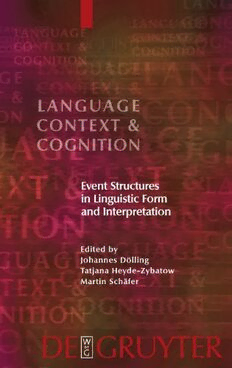Table Of ContentEvent Structures in Linguistic Form and Interpretation
Language, Context, and Cognition
Edited by
Anita Steube
Volume 5
w
DE
G
Walter de Gruyter · Berlin · New York
Event Structures
in Linguistic Form
and Interpretation
Edited by
Johannes Dölling
Tatjana Heyde-Zybatow
Martin Schäfer
w
DE
G
Walter de Gruyter · Berlin · New York
© Printed on acid-free paper which falls within the guidelines
of the ANSI to ensure permanence and durability.
Library of Congress Cataloging-in-Publication Data
Event structures in linguistic form and interpretation / edited by
Johannes Dölling, Tatjana Heyde-Zybatow, Martin Schäfer,
p. cm. — (Language, context, and cognition)
Includes bibliographical references and index.
ISBN 978-3-11-019066-3 (alk. paper)
1. Grammar, Comparative and general — Syntax. 2. Grammar,
Comparative and general — Verb phrase. 3. Semantics. I. Dölling,
Johannes. II. Heyde-Zybatow, Tatjana, 1973— III. Schäfer, Mar-
tin, 1975-
P295.E96 2007
415—dc22
2007005990
ISBN 978-3-11-019066-3
Bibliographic information published by the Deutsche Nationalbibliothek
The Deutsche Nationalbibliothek lists this publication in the Deutsche
Nationalbibliografie; detailed bibliographic data are available in the Internet
at http://dnb.d-nb.de.
© Copyright 2008 by Walter de Gruyter GmbH & Co. KG, D-10785 Berlin
All rights reserved, including those of translation into foreign languages. No part of this
book may be reproduced or transmitted in any form or by any means, electronic or
mechanical, including photocopy, recording or any information storage and retrieval
system, without permission in writing from the publisher.
Printed in Germany
Cover design: Christopher Schneider, Berlin
Printing and binding: Hubert & Co. GmbH & Co. KG, Göttingen
Contents
Introduction IX
Section I: Event Structure and Syntactic Construction
Patients in Igbo and Mandarin 3
Alexander Williams
Event decomposition and the syntax and semantics
of durative phrases in Chinese 31
Jo-wang Lin
Syntactic decomposition of events in Korean and Standard Indonesian 55
Minjeong Son and Peter Cole
Section II: Event Structure and Modification
Unifying illegally 81
Kyle Rawlins
Adverbial modification of adjectives: Evaluatives and a little beyond 103
Marcin Morzycki
The structure of criterion predicates 127
Kjell Johan Sceb0
Reference to embedded eventualities 149
Markus Egg
Section III: Event Structure and Situation Aspect
Two puzzles for a theory of lexical aspect: Semelfactives
and degree achievements 175
Susan Rothstein
The notion of 'path' in aspectual composition: Evidence from Japanese 199
Eri Tanaka
VI Contents
Reflexive intransitives in Spanish and event semantics 223
Eric McCready and Chiyo Nishida
Scalar complexity and the structure of events 245
John Beavers
Section IV: Event Structure and Plurality
On the plurality of verbs 269
Angelika Kratzer
Event quantification and distributivity 301
Kimiko Nakanishi
The event structure of irreducibly symmetric reciprocals 327
Alexis Dimitriadis
Existential readings for bare plurals in object position 355
Sheila Glasbey
Section V: Event Structure and Temporal Location
Tense and adverbial quantification 389
Cornelia Endriss and Stefan Hinterwimmer
Phase structure and quantification 413
Marko Malink
Cohesion in temporal context: The role of aspectual adverbs 435
Alice G.B. ter Meulen
Mandarin sentential -le, perfect and English already 447
Hooi Ling Soh and Meijia Gao
Section VI: Event Structure and Natural Language Ontology
The lower part of event ontology 477
Regine Eckardt
Verbs of creation 493
Christopher Piñón
Contents VII
Portraits of the Authors 523
Index 527
Introduction
This volume comprises a selection of papers presented at the workshop "Event
Structures in Linguistic Form and Interpretation", which took place at the Uni-
versity of Leipzig in March 17-19, 2004. The workshop was hosted by the
research project "Event Structures: Grammatical and Conceptual Components
of Utterance Interpretation" at the Department of Linguistics of the University
of Leipzig. The central topic to be addressed was how conceptual information
on event structure is encoded in linguistic expressions and how such informa-
tion can be reconstructed from utterances. Answers to these questions essen-
tially contribute to a better understanding of the relationship between lexical
semantics, syntactic structure, pragmatic inference, and world knowledge in a
broader cognitive perspective.
Among the many collections on event-based semantics and syntax appear-
ing over the last ten years (e.g. Rothstein, 1998; Tenny and Pustejovsky, 2000;
Higginbotham, Pianesi and Varzi, 2000; Lang, Maienborn and Fabricius-
Hansen, 2003; Austin, Engelberg and Rauh, 2004; Maienborn and Wöllstein,
2005; and Verkuyl, de Swart and van Hout, 2005), this volume adopts a decid-
edly applied attitude in that the existence of Davidsonian event arguments is
taken as given and that problems of the fundamental methodology are of minor
concern. Instead, it demonstrates how the idea of event structure can be suc-
cessfully applied to a wide range of empirical problems in an increasing num-
ber of languages. Thus, the topic is discussed not only on the basis of English
and German but, among others, of Mandarin Chinese, Japanese, Korean, Indo-
nesian, and Igbo as well.
The contributed papers fall into several broad classes - accounting for event
structure in connection with syntactic construction, modification, situation
aspect, plurality, temporal location, and natural language ontology. Accord-
ingly, the volume is organized into six sections.
Section I: Event Structure and Syntactic Construction
The assumption of an event-related framework in research on verb meaning
raises important questions for the analysis of the syntax/semantics interface.
While it is uncontroversial that event structure is to some degree reflected in
syntactic structure, there is an ongoing discussion about the sort of verbal in-
formation that should play a role in the syntactic derivation. Two different
strategies of meaning decomposition, which can be traced back to the Genera-

